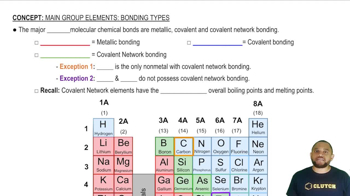Here are the essential concepts you must grasp in order to answer the question correctly.
Hybridization
Hybridization is the concept that describes the mixing of atomic orbitals to form new hybrid orbitals, which can explain the geometry of molecular bonding. In organic molecules like cinnamaldehyde, carbon atoms can exhibit different hybridizations (sp, sp2, sp3) depending on their bonding environment. For example, sp2 hybridization occurs in carbon atoms involved in double bonds, leading to a trigonal planar arrangement.
Recommended video:
Types of Bonds
In chemistry, bonds between atoms can be classified as sigma (σ) and pi (π) bonds. Sigma bonds are formed by the head-on overlap of orbitals and are present in all single bonds, while pi bonds result from the side-to-side overlap of p orbitals and are found in double and triple bonds. Understanding the number of each type of bond in a molecule is crucial for determining its structure and reactivity.
Recommended video:
Molecular Structure
The molecular structure of a compound refers to the arrangement of its atoms and the types of bonds connecting them. In cinnamaldehyde, the structure includes a carbonyl group (C=O) and a double bond between carbon atoms, which influences its physical properties and reactivity. Analyzing the structure helps in identifying hybridization and the total number of bonds present in the molecule.
Recommended video:
 McMurry 8th Edition
McMurry 8th Edition Ch.8 - Covalent Compounds: Bonding Theories and Molecular Structure
Ch.8 - Covalent Compounds: Bonding Theories and Molecular Structure Problem 75
Problem 75



